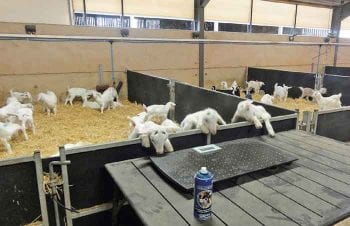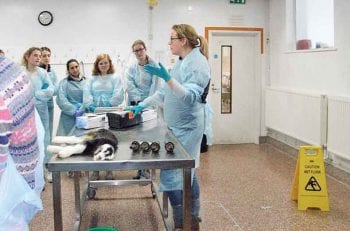24 Jun 2019
David Harwood reports on a mix of topics including disbudding best practice at the Goat Veterinary Society's spring meeting.

Figure 1. A typical large UK commercial dairy goat unit.
Members of the Goat Veterinary Society (GVS) gathered at Haydock Park Racecourse, Merseyside for its spring meeting.
Ahead of the event, members were told of the society’s forthcoming 40th anniversary meeting to be held in Thirsk in October. Programme secretary Kathy Anzuino had developed an excellent programme for the remainder of the day.
Our overseas speaker was Vicki McLean, who is originally from California, but now working in New Zealand as a goat veterinary consultant. New Zealand has a human population of only 5 million – along with 30 million sheep and around 60,000 commercial dairy goats.
The speaker works for the Dairy Goat Co-operative, set up 30 years ago, and now with 71 suppliers throughout New Zealand. The company focuses almost solely on producing nutritional dried goat milk powders for newborn babies and toddlers, which is exported to 25 countries worldwide.
The herds themselves comprise a total of 51,000 milkers and 20,000 kids. Average herd size is between 300 to 700, with 3,000 the maximum number permitted. Most are housed to control gut parasites, but six manage outdoor production. Understandably, a very high demand for milk quality exists, with rigorous
testing and resulting penalties for failures. Each unit must have an official veterinary audit annually for both goat health and welfare.
Kathleen Weilkopolski of Yorkshire Dairy Goats began by describing the firm’s enterprise – consisting of two herds of 3,000 milking goats each (Figure 1). It averages around 1,600 litres in a 365-day lactation. The herd has been innovative in developing in-house genomic breeding keys, now playing a part in selection
for productivity and other parameters. Goats are seasonal breeders that can be manipulated to breed out of season – an important factor when considering all-year-round milk production to satisfy consumer demand.
Another approach to achieve this is to not re-breed, but to manage for an extended lactation. As there are, in effect, fewer pregnancies, fewer kids are produced, with reduced stress on staff and other resources.
One disadvantage that needs careful management is the problem of goats getting overfat, as this, in turn, makes them less fertile when they breed again, and more likely to have problems at kidding and develop pregnancy toxaemia. As the level of out-of-season breeding decreases as a result of extending lactations,
the number of false pregnancies is also reduced as these seem to be more prevalent when the breeding season is manipulated by whatever means is used to achieve it.
Ms Anzuino, who is undertaking a PhD project linked to commercial dairy goat production, gave an update on a kid rearing project involving 25 farms – looking specifically at colostrum quality, and kid growth and health. She found more farms were removing kids at birth – possibly linked to Johne’s disease control.
Reassuringly, she also found very little use existed of routine medications at birth, although colostrum management was quite variable from farm to farm. Colostrum was collected and assessed for immunoglobulin levels – together with fat, protein and lactose analysis achieved using a Brix refractometer.

She also assessed the success of passive transfer of immunity by blood testing kids. As part of her study, she collects and collates several health factors on each farm – including any evidence of nasal/ocular discharge, presence of a cough, faecal soiling, joint swellings, presence of skin lesions and evidence of herd lameness – together with an overall assessment of body condition (Figure 2).
Kid growth rates were also evaluated by peer comparison at birth, 7, 21 and 56 days old – and compared with other associated data gathered.
The GVS has been actively involved in highlighting the importance of analgesia when disbudding a kid, but also in creating an awareness of best practice when carrying out the procedure. Bryony Kendall of Tyndale Vets gave a presentation on her recent experiences teaching the procedure to vet students – and
the need to update GVS training material.
A workshop took place at this year’s Farm Association of Veterinary Students Congress at Langford, in which students were shown the technique on dead kids and then had the opportunity, under supervision, to disbud a kid (Figure 3). Many students graduate with never having undertaken the procedure or even seen
it being undertaken, and this is of concern.
Historically, the GVS produced a DVD, funded by the Animal Welfare Foundation, but this needs updating – particularly with reference to medicine availability and use. Many other disbudding irons are available than those illustrated in the DVD. Training will also be available on the procedure at this year’s London
Vet Show.

The next speaker was Ben Strugnell of Farm Post Mortems, who began by outlining the postmortem service he runs in the north-east. During the past four years he would have undertaken around 1,000 postmortems on ewes at a fallen stock centre. He then collated the results obtained to identify the common conditions ewes die of. He had also examined around 1,200 cull ewes to determine what ewes die with – that is they showed signs of disease that had not killed them.
Mr Strugnell gave a list of 17 conditions he had identified ewes died from, with ovine pulmonary adenocarcinoma (OPA) and Johne’s disease the two most common. In his geographical area, he estimated this accounted for around 15% of all ewe deaths. Moving on to production-limiting conditions he
included (in addition to Johne’s and OPA) border disease, maedi-visna and caseous lymphadenitis (CLA) – each of which could potentially be bought into an uninfected flock.
Miscellaneous conditions identified at ewe postmortem included chronic suppurative pneumonia, often linked to a septic focus elsewhere (for example, foot lesion, dirty needle abscess or tooth root abscess), and a variety of dentition problems.
The speaker then posed the question as to whether these approaches (that is, postmortem examination of dead and cull does on farms) could be applied to the dairy goat sector – leaving the audience with much to consider.
The author and GVS senior vice-president began by discussing enterotoxaemia in goats caused by Clostridium perfringens type D. This same organism causes pulpy kidney in sheep, but the clinical presentation is quite different, with the primary lesion in goats being a severe enterocolitis. The clinical signs are quite characteristic. The condition can be confirmed at postmortem by examining gut content for toxin – this same test gives variable results on faeces in live goats.
Moving on to caprine arthritis encephalitis (CAE), the author described an indurative mastitis to be a feature commonly identified in milking goats, in addition to the more typical signs of arthritis. The ELISA blood test can be used to help confirm or rule out disease in clinically infected goats as well as being a good screening test. Johne’s disease is not just a disease of farmed goats, but has been identified in pet pygmy breeds. The ELISA blood test needs to be interpreted carefully as it doesn’t pick up goats that are subclinically affected and healthy. Gut pathology is also more subtle than the typically thickened gut commonly recognised in infected cattle.
The audience was reminded that elderly teenage goats are susceptible to a range of neoplasia, including thymic lymphosarcoma, mammary adenocarcinoma and tumours of the female reproductive tract.
In her second presentation, Dr McLean compared and contrasted some veterinary and animal health concerns between the UK and New Zealand. Not surprisingly, Johne’s disease was common to both – particularly as in New Zealand the dried milk powder product produced was directed at the young and
vulnerable human population, coupled with the ongoing concerns over its zoonotic role.
Other concerns were how to reduce the high somatic cell counts found in some herds, how to control clostridial spore contamination of the finished
product (a problem apparently unique to New Zealand), and a constant monitor on the iodine levels in the milk and finished product.
Specific health problems common to both countries included lameness, CLA, listeriosis and false pregnancy in does, and bloat pneumonia, umbilical infection and coccidiosis in kids. The Dairy Goat Co-operative had recently developed a CAE-accreditation scheme subsidised initially for early takers, but now at the stage where producers must pay if they wish to join.
The final paper of the day came from GVS secretary Ben Dustan. He described a herd of 28 castrated Boer goat kids, 6 to 9 months old, that had been badly neglected, and were pruritic and emaciated with extensive skin lesions over the lower parts of their limbs. These lesions were causing obvious discomfort, as the
kids constantly stamped their feet, and rubbed their legs on fixtures and fittings.
Initial examination for ectoparasites on the limbs at the margin of the lesion was unrewarding, but chorioptic mange mites were found elsewhere on the body, confirming their likely involvement as the lesion distribution was typical.
The whole group was treated with Eprinex pour-on (with a marketing authorisation for use in goats), and the same product was also dabbed on the affected areas of the worst-affected kids. A steady improvement was seen even by seven days post-treatment, and by one month later, skin lesions had healed and hair was growing back.